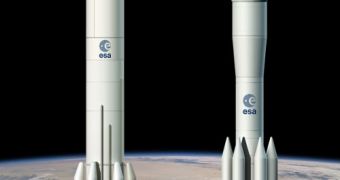In spite of its nearly-irreproachable track record, the Ariane 5 heavy-lift delivery system will be replaced by the European Space Agency (ESA) over the coming decade. The agency has just signed a €60 million contract with a propulsion consortium for the development of the next-generation rocket.
Details about the Ariane 5 successor are still scarce, as the initiative is still only on its infancy. However, the NGL Next-Generation Launcher is already generating a lot of buzz from the industry.
ESA is moving fast in this project. At the Paris Air & Space Show, which began on June 20, it already signed an important NGL contract, which awards Joint Propulsion Team with 60 million euros to design the main engines that will power the future rocket.
JPT is a consortium made up of Astrium GmbH, Avio SpA and Snecma of Safran Group. The agreement was signed under the guises of the ESA Future Launchers Preparatory Program (FLPP).
NGL is considered to be an institutional need in Europe, as it would ensure and safeguard ESA's access to space in the long run. The European Union recently made it clear that the agency always needs to have effective and economic launchers at its disposal, in case they are needed.
The FLPP was set up as a direct response to this necessity. The program and its managers are responsible for “identifying and studying new launch vehicle concepts and anticipating the technologies to make them possible,” ESA explains.
At this point, there are four NGL configurations that the space agency is considering for future development. In all of them, it would appear, liquid propulsion is taking center stage. Engineers say that this type of propulsion has great flexibility, growth potential and track record.
The objective of the new contract between ESA and the JPT is the development of the liquid-propelled High-Thrust Engine (HTE) demonstrator, which is one of the candidates ESA believes are most promising for use on NGL.
“The High-Thrust Engine project completed the system requirements review in May, proving the maturity of the selected design. The project has already delivered significant technological achievements, including several European ‘firsts',” says ESA Propulsion Project Manager Jérôme Breteau.
“It is now heading towards the preliminary design review planned for mid-2012. Hot-firing tests will be performed around 2014, which could also evolve towards a pre-development phase,” he goes on to say.

 14 DAY TRIAL //
14 DAY TRIAL //